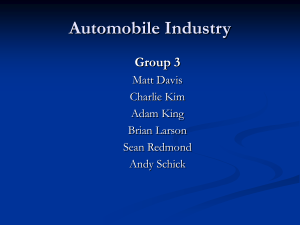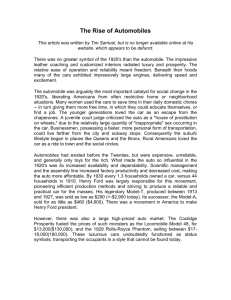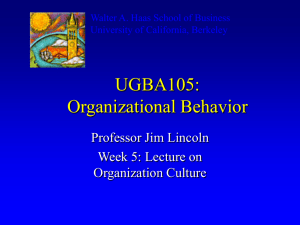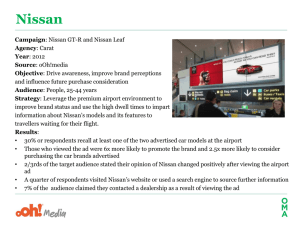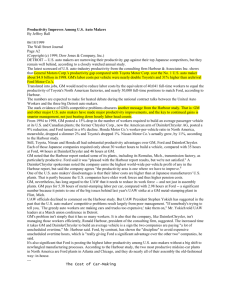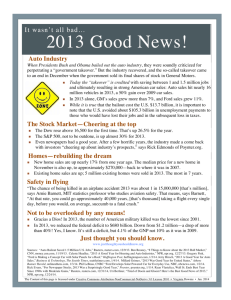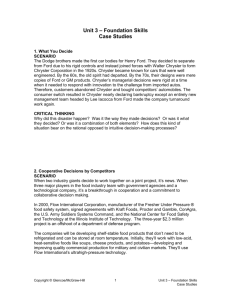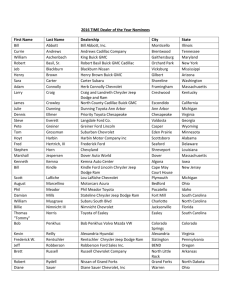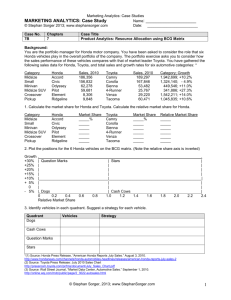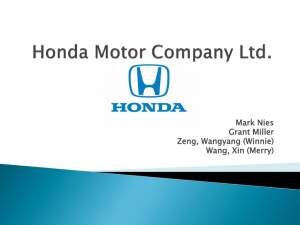Present marketing research
advertisement
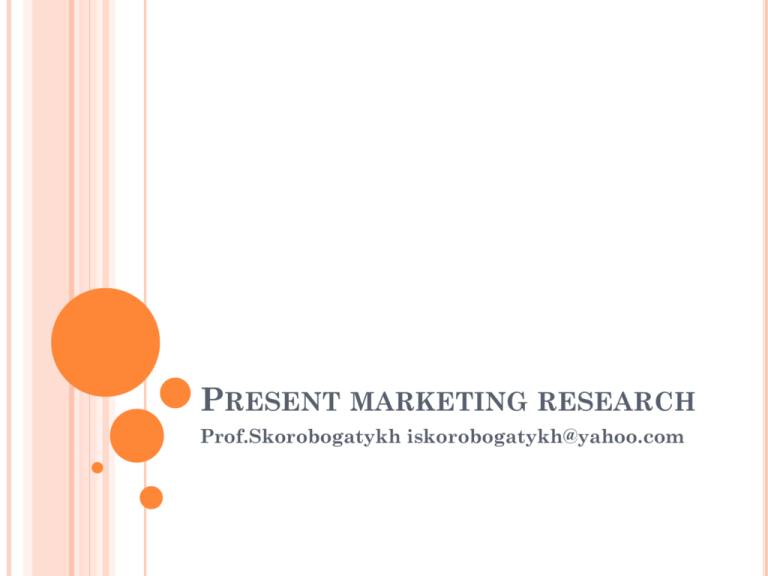
PRESENT MARKETING RESEARCH Prof.Skorobogatykh iskorobogatykh@yahoo.com INTRODUCTION The final report is the most important part of the research Wilson‘s six-point suggestion for the presentation of research focuses on the audience‘s needs: 1. Respect the importance 2. What do they need from report? 3. How does your report meet this need? 4. Underpin the key information with evidence 5. Remind them of the key points of the report 6. Make recommendations as to action THE INITIAL UNDERSTANDING OF THE REPORT WRITING Report provides a ‗permanent‘ record of the quality of the research Researcher should take into account the audience-thinking sequence that people go through when communicating with them Report should contain several elements and can be constructed in a logical manner AUDIENCE THINKING SEQUENCE Respect the client’s importance (don‘t waste time with irrelevant, badly structured, poorly presented information) Consider the client’s needs. Demonstrate how information can help client. The client needs to Think of what the client requires from the research (rationale of the research and research objectives) make marketing decision Explain the detail that underpins the information Provide charts, tables, statistics, and other form of evidence that support the findings, and which anticipate any questions may arise Remind clients of the key points. ‘tell them what you‘ve told them‘ in summary format Suggest what the client should do now. The report is likely to offer a range of options, and the client should ultimately decide, but the report usually provides recommendations about possible courses of actions, and issues to be addressed THE MARKETING RESEARCH WRITTEN REPORT FORMAT Title page Contents page The Executive summary Introduction Situation analysis and problem definition Research methodology and limitations Findings and analysis Conclusions and recommendations Appendices DESCRIPTION OF WRITTEN REPORT The title page – should include the name and contact details of the agency and the researcher, client details and date of presentation The contents – list the major headings and sub-headings, list of tables and figures, and their associated page numbers The Executive summary – tight précis of the subject matter of the report, its recommendations and conclusions The introduction should outline the key objectives of the research, the reasons for the research, and its constraints. Also contain the profiles and responsibilities of the researchers DESCRIPTION OF WRITTEN REPORT (CONT) The research Method – briefly outline the methods used, information about where samples have been obtained, topic discussion guides or questionnaire, (any changes (if so) since the proposal stage) The research findings and Analysis – main body of the report (should be constructed to present the solution of the problem) The conclusions – the implication of the findings for the client (with reference to initial problem) Appendices and Index – supporting data and information (tabs, graphs, lists of secondary sources, the questionnaire, discussion documents) GENERAL GUIDANCE A marketing research report should reflect on understanding the problem, gained from diligent, well-planned and appropriate analysis of the situation. Report should be as short as possible (but contain the necessary information) The recommendation should be a logical conclusion constructed on the research findings Findings should be accurate, Statistics contained should be based on statistical principles using appropriate tables and graphs to illustrate the information derived from the data The Report Preparation and Presentation Process Problem Definition, Approach, Research Design, and Field Work Data Analysis Interpretations, Conclusions, and Recommendations Report Preparation Oral Presentation Reading of the Report by the Client Research Follow-Up THE EXECUTIVE SUMMARY Short summary of the whole report and its recommendations Should be written after the report is made, but should start the report. EXAMPLE OF THE REPORT Abstract Ex.summary Acknowledgements Introduction Industry background – the market A changing distribution network Changing consumer values The franchised dealer The organization background The brand The future (some predictions) Research objectives Research methodology Sampling procedure and size Research methods In-depth interviews Staff focus groups Customer focus groups Data analysis and evaluation Research findings Primary research overview Strategic direction of the brand Staff perception of the brand Staff and customer value Loyalty and interaction of staff Effective communication Measurement as a behavioral driver Customer value of experience Brand decision making Appendices App A: in-depth interview guide App b: staff focus group discussion guide App C: customer focus group discussion guide App d: CD Rom recording in-depth interview App F: video footage of focus group Terms of reference THE ORAL PRESENTATION Introduction Introduce the research team Agenda Research background and objectives Methodology Key findings Conclusion and recommendation Questions??? Guidelines on the Title Page Use client language in title — avoid "research-eze‖ • "Practices Followed in Selecting Long- Distance Carriers" is better than "Long-Distance Service Study‖ • ―Customers' Reactions to an Expanded Financial/ Insurance Relationship‖ is better than "Relationship Study" Guidelines on Conclusions and Recommendations CONCLUSIONS Conclusions concerning, for example: * customer behavior * customer attitudes or perceptions * the nature of the markets studied Generally, in studies with samples designed to represent the market. Avoid interesting results that are not relevant to the conclusions • May be in the form of statement or paragraphs • Use subheadings to identify conclusions covering different subjects or market segments RECOMMENDATIONS • Recommendations regarding actions that should be taken or considered in light of the research results: * Add/drop a product * What to say in advertising__advertising positioning * Market segments to select as primary targets * How to price product * Further research that should be considered • Should be related to the stated purpose of the research • Sometimes omitted, for example: * Client staff members want to author the recommendations * Study designed merely to familiarize client with a market • Most clients are interested in our suggestions, in spite of the fact that we may not be familiar with internal financial issues and other internal corporate factors USE OF GRAPHICS: TABLES Tables should be presented with title and a number The table should show the figures of samples and subsamples which were used in the research 75% is an impressive statistical figure, but if the full picture is that the sample was only 10 people, it is less so. U.S. Auto Sales 2002-2005 Table 22.1 U.S. Auto Sales 2002-2005 5b 4a 1a 1b 4b 3a 5a 4c 2a UNIT SALES Mfg 2002 2003 2004 2005 1996 GM 2,843,860 2,908,6893,057,8722,930,568 2,757,671 Ford 1,777,6356 1,878,1491,938,8411,791,225 1,737,252 Chrysler 679,586 834,132 811,824 786,180 Toyota 760,159 741,826 765,143 793,974 793,592 Honda 768,845 716,440 762,242 740,487 786,154 Nissan 417,970 482,646 537,228 520,258 500,377 Other 965,058 955,977 1,117,367 832,633 TOTAL 8,213,1138,517,8598,990,517 8,634,964 1,072,272 1,119,074 8,526,753 5c *Includes all other producers. Source: 2005 Ward‘s Automotive Yearbook, p.195. 6a Pie Chart of 2006 U.S. Auto Sales 6% Nissa n 13% Othe r 9% Hond a 9% Toyot a 10% Chrysle r 33% GM 20% Ford Line Chart of Total U.S. Auto Sales 3,500,000 GM Units 3,000,000 2,500,000 2,000,000 Ford 1,500,000 Others 1,000,000 Chrysler Honda Toyota 500,000 Nissan 0 2002 2003 2004 2005 2006 Stratum Chart of Total U.S. Auto Sale 10,000,000 9,000,000 Others 8,000,000 Nissan Honda Toyota Units 7,000,000 6,000,000 5,000,000 Chrysle r 4,000,000 Ford 3,000,000 2,000,000 GM 1,000,000 0 2002 2003 2004 2005 2006 Pictograph for 1996 U.S. Auto Sales Each Symbol Equals 1,000,000 Units Units GM 2,757,671 Ford 1,737,252 Chrysler 832,663 Toyota 793,592 Honda 786,154 Nissan 500.377 Others 1,119,074 Histogram of 2006 U.S. Auto Sales 3 Million of Units 2.5 2 1.5 1 0.5 GM Ford Chrysler Toyota Honda Nissan Others Make
